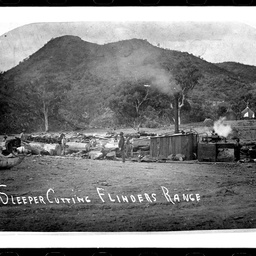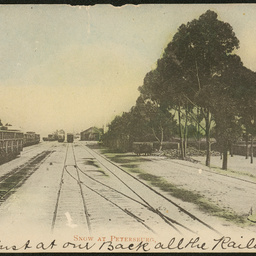Find • 1907 • Results 631 to 660 of 2,044


Jetty, Neptune Island
Neptune Island Jetty. Neptune Islands are situated close to Spencer Gulf and Cape Catastrophe. The jetty is near the light house and keeper's house.


The Parade, Norwood
The Parade at Norwood.


Railway Cottages, Oodnadatta
Railway cottages at Oodnadatta.


Outer Harbor
Outer Harbor, in the course of construction. The wharf and cranes can be seen as the new facility is built.


S.S."Oruba", Outer Harbor
S.S. "Oruba" at Outer Harbor. This single screw steam packet carried three classes of passengers as well as the Royal Mail. See also the reverse of B 10986 for a further view of Outer Harbor.


Outer Harbor
Outer Harbor under construction took place at the beginning of the 20th century, accommodating larger ships and reducing the time need to sail up the Port River to the inner harbour.


Outer Harbor
Outer Harbor construction took place at the beginning of the 20th century, accommodating larger ships and reducing the time need to sail up the Port River to the inner harbour.


Outer Harbor
Outer Harbor.


Outer Harbor
[General description] Sea, sky and a breakwater dominate this view of Outer Harbor with the wharves seen in the distance. A small steam craft is in the foreground and a steam dredge is in operation.


Outer Harbor
Outer Harbor under construction.


Outer Harbor
Outer Harbor under construction.


Outer Harbor
Outer Harbor.


Camels train, Parachilna
A string of camels on their last haul.


Steam Motor Coach No.1
Steam Motor Coach No.1 (later known as the Coffee Pot) at Parachilna.


Railway sleepers, Parachilna
Cutting railway sleepers east of Parachilna.


Loading wool at Parachilna
Loading wool on to a wagon.


Camel transport, Parachilna
Miss Annie and Mr.James Darmody riding a camel outside the hotel.


Camel train, Parachilna
Camels with their young - part of a camel train.


Parachilna Creek
Parachilna Creek rises as Blinman and Wockerawirra Creeks around Mount Emily and they flow for about 20 km westwards where they merge through the ABC and Heysen Ranges before eventually discharging into Commodore Swamp. The name Parachilna comes from the Aboriginal word patajilnda meaning place of peppermint gum trees


Penola Council Chambers
[General description] Penola district Council Chambers is a solid single storey stone building with a portico and arched door and windows. A picket fence encloses its garden.


Penola Township
[General description] Street view in Penola township showing various shops and businesses and street trees. In the centre left of the view is a small shop, the premises of Balnaves Department Store.


Penola Institute
[General description] Penola Mechanics Institute and Public Library, built in 1869. It is still in use today (2018) as a visitor centre. It is a single storey stone building with arched doors and windows across its facade. A poster out front advertises a concert by Lena Conly. The Lutheran Church is on the right.


Penola Township
[General description] Penola township - street scene.


Penola Railway Station
[General description] Penola Railway Station. It was one of several built to the same design by architect Alfred McBain Bonython at Moonta, Tailem Bend, Wallaroo and Murray Bridge. Railway officials stand in front of the building.


Wilson house, Penola
Nellie Wilson's house situated off Church Street, Penola. A researcher has provided the following information: 'Nellie Wilson (1907-1980) lived in this house from her 1929 marriage to Roderick Clarence (Clarrie) Wilson (1895-1970) to her death at the house in September 1980. Clarrie's parents had lived in the house before them. The land was purchased by Clarrie's father James Wilson in the 1870s. Clarrie's grandfather was Penola pioneer William Wilson. Nellie and Clarrie raised two daughters in htis house, Mona June Wilson (1931-2017) and Ruth Jean Wilson (1932-2001). This house was on a one acre block, and was sold to Max and Margaret Hage in 1981.'


Railway Yard, Peterborough
Railway coaling yard, Peterborough. The railway arrived in Petersburg (later Peterborough) in 1881 when the line from Jamestown opened. Carriage of ore from Broken Hill to the smelters at Port Pirie was the major contributor to the rail traffic through Peterborough with 70 trains a day passing through the town in 1898. Over the next fifteen years the line was recognised as the busiest single track railway in the world (1911-1914 especially so)


Peterborough
Peterborough showing the Railway Hotel. The proprietor at this time was CFT Cocks. The hotel was built in approximately 1880 at the same time as the post office, followed by the town hall and a school. The town was renamed Peterborough in 1917 from it's original name of Petersburg due to anti-German sentiments during World War I.


Post Office, Peterborough
Post Office at Peterborough. The Post Office and Hotel were built in 1880, followed by the Town Hall and a school. The town was renamed Peterborough in 1917 from it's original name of Petersburg due to anti-German sentiments during World War I.


Railway Lines, Peterborough
Peterborough railway lines under snow.


Pine Point Landing
[General description] The tide is out at Pine Point Landing where a coastal ketch is moored. A lighter from a steamer anchored in deeper water is approaching.
